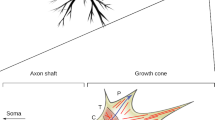Abstract
How can biological plasticity been added to a simulation of neuritic growth? Coming from this question, we have chosen a new access to simulate neuritic growth under the very aspect of meaningful and progredient development of single cells. Based on a specific description-language, we have set up a computer-program, to construct neurite-models and to simulate neuritic interaction during their development. Instead of using mathematical equations, we define various types of cytoskeletons by taking a specified graph grammar. Using this technique, we are able to define strings, combined with other influencing parameters, which allow the setting up of very naturally behaving artificial nervecells, in which distinct statistical variance and fixed rules as given in DNA operate together. In this paper, we want to discuss the underlying principles of the given grammar and to show some results from these computer-simulations, which enable us to study growth, development and other specific characteristics of neurites within a simulator in comparison to in vivo-experiments.
Similar content being viewed by others
References
Aono M (1984) Botanical tree image generation. IEEE Comput Graph Appl 4:10–34
Barnsley MF, Devaney RL, Mandelbrot BB, Peitgen HO, Saupe D, Voss RF (1989) The science of fractal images. Springer, Berlin Heidelberg New York
Bastiani MJ, Dol CQ, Helfand SL, Goodman CS (1985) Neuronal specifity and growth cone guidance in grasshopper. Trends Neurosci 8:257–266
Brandt I (1981) Brain growth, fetal malnutrition. J Perinat Med 9(3):3–26
Bray D (1979) Model for membrane movements in the neural growth cone. Nature 244:93–95
Brown AG (1991) Nerve cells and nervous systems. Springer, Berlin Heidelberg New York
Campenot RB (1977) Local control of neurit development by nerve growth factor. Proc Natl Acad Sci USA 74:4516–9
Crutcher (1986) Sympathetic sprouting in the central nervous system: a model for studies of axonal growth in the mature mammalian brain. Brain Res Rev 12:203–233
Davies AM (1986) Different factors from the central nervous system and periphery regulate the survival of sensory neurons. Nature 4:11–20
Dimitrijevic MR (1988) Model for the study of plasticity of nervous system: features of residual spinal cord motor activity resulting from established posttraumatic injury. In: CIBA Foundation Symposium, pp 227–39
Does D, Lindenmayer A (1983) Algorithms for the generation and drawing of maps representing cell clones. In: Graph grammars and their application. Springer, Berlin Heidelberg New York
Eichhorst P (1980) Growth functions of stochastic Lindenmayer systems. Information Control 45:217–228
Herman GT, Lindenmayer A (1975) Description of developmental languages using recurrence systems. Math Systems Theory 8:316–341
Jeanpretre N, Clarke PGH (1991) Axonal competition analysed mathematically. Abstract, Societe Suisse D'Anatomie, D'Histologie et D'Embryologie, 53e reúnion anuelle
Jürgensen S, Lindenmayer A (1987) Inference algorithms for developmental systems with cell lineages. Bull Math Biol 49(1):93–123
Kolb B, Whishaw IQ (1989) Plasticity in the neocortex: mechanisms underlying recovery from early brain damage. Prog Neurobiol 31:235–276
Letrourneau PC (1979) Cell substratum adhesion of neurite growth cones and its role in neurite elongation. Exp Cell Res 124:127–138
Lindenmayer A (1968a) Mathematical models for cellular interactions in development. I. Filaments with one-sided inputs. J Theor Biol 18:280–299
Lindenmayer A (1968b) Mathematical models for cellular interactions in development. II. Simple and branching filaments with two-sided inputs. J Theor Biol 18:300–315
Lindenmayer A (1974) Adding continues components to L-systems. In: Rozenberg G (eds) L-systems. Springer, Berlin Heidelberg New York
Lindenmayer A (1975) Development algorithms for multicellular organisms: a survey of L-systems. J Theor Biol 54:3–22
Lindenmayer A (1979) Parallel generation of maps: developmental systems for cell layers. In: Claus V, Ehrig H, Rosenberg G (eds) Graph-grammars and their application to computer science and biology. Springer, Berlin Heidelberg New York
Linke BD, Linke BM, Linke R, Kurthen M, Durwen HF, Fromm G (1988) Functional plasticity of the nervous system with special referene to cultural neuropsychology. In: Herrmann (eds) Higher nervous function. Vieweg, Braunschweig, pp 11–19
Mandelbrot B (1980) Fractal aspects of the iteration of z → lambda(z)(1-z) for complex lambda and z over n Ann NY Acad Sci 357:249–259
Mandelbrot B (1984) Fractals in physics: squig clusters, diffusions, fractal measures, and the unicity of fractal dimensionality. J Stat Phys 34:895–930
Mandelbrot B, Wallis JR (1968) Fractal Brownian motion, fractal noises and applications. SIAM Rev 10(4):422–437
Pellionisz A (1983) Brain theory: connecting neurobiology to robotics, tensor analysis: utilizing intrinsic coordinates to describe, understand and engineer functional, geometries of intelligent orgamisms. J Theor Neurobiol 2:185–211
Pellionisz A (1989) Vistas from tensor network theory: a horizon from reductionalist neurophilosophy to the geometry of multiunit recordings. In: Cotterill R (eds) Computer simulations in brain sciences. Cambridge Press, New York, pp 45ff
Pellionisz AJ (1985) Tensorial brain theory in cerebellar modelling. In: Bloedel J, Dichgans J, Precht W (eds) Cerebellar functions. Springer, Berlin Heidelberg New York, pp 201–229
Prusinkiewics P (1989) Lindenmayer systems, fractals and plants, Springer, Berlin Heidelberg New York
Purves D (1988) Body and brain. Harvard University Press, Cambridge London
Rall W, Segev I (1989) Excitable dendritic spine clusters: nonlinear synaptic processing. In: Cotterill RMJ (eds) Computer simulations in brain science. Cambridge University Press, Cambridge, pp 26–43
Rall WJ (1973) Branch input resistance and steady attenuation for input to one branch of a dendritic neuron model. Biophys J 13:648–88
Schrade M (1989) The guru of silicon chips, Carver Mead is shaping an entire industry with his approach to the gray matter of computer brains. Los Angeles Times (May 21th, 1989) p 3
Siromoney R (1986) Array languages and Lindenmayer systems — a survey. In: Rozenberg G (eds) L-systems. Springer, Berlin Heidelberg New York
Skoff RD, Hamburger V (1974) Fine structure of dendritic and axonal growth cones in embryonic chick spinal cord. J Comp Neurol 153:127–156
Veen M, Alt W (1991) Simulation models for outgrowth and protrusion of neurons ans other tissue cells. Proc of First European Conference on Mathematical Applications in Medicine and Biology, Genev
Author information
Authors and Affiliations
Rights and permissions
About this article
Cite this article
Hamilton, P. A language to describe the growth of neurites. Biol. Cybern. 68, 559–565 (1993). https://doi.org/10.1007/BF00200816
Received:
Accepted:
Issue Date:
DOI: https://doi.org/10.1007/BF00200816




